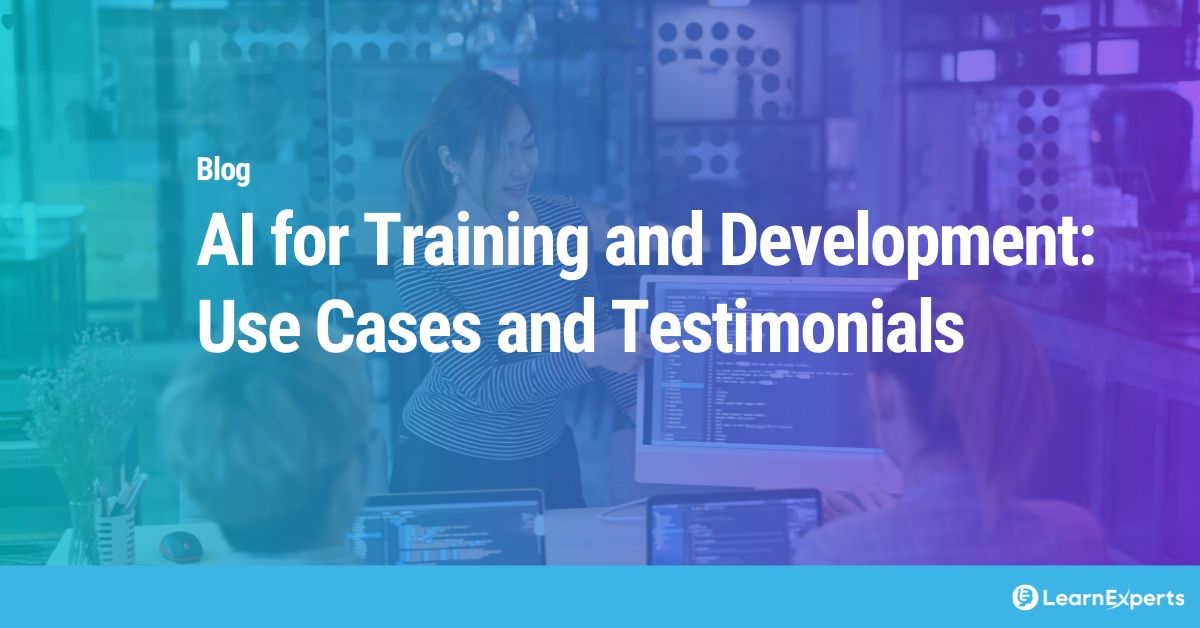According to research by the Boston Consulting Group, people are both excited and concerned about AI. Sixty percent of respondents say AI will help with learning and education, while 55 percent anticipate workplace efficiencies. At the same time, people are concerned about the impact on jobs and data security, to name a few.
Like many other professionals, training and L&D creators now have a vast array of AI tools available that transform the learning experience and make creating new courses easier and faster. Christopher Pappas, founder of eLearning Industry, had the following to say about how AI has changed course design and content personalization:
At eLearning Industry Inc., we’ve explored various AI tools to enhance our course creation and Learning and development (L&D) initiatives. We recently integrated an AI platform to streamline course design and content personalization. This tool leverages machine learning to analyze learner data and tailor the course content to better suit individual learning styles and paces.
The results have indeed met our expectations. The AI’s ability to adapt content in real-time based on learner interaction has improved engagement and our courses’ overall effectiveness. What stands out most is the tool’s efficiency in reducing the manual workload on course developers, allowing them more time to focus on creative and strategic tasks. This shift has significantly boosted productivity and satisfaction among our team.
AI for content creation
The benefit of using AI for training content creation is that it can analyze many documents and information sources and quickly suggest relevant learning topics, module structures, and test questions for eLearning, instructor-led training, microlearning and videos.
Many tools offer varying degrees of content creation capabilities, but this is how Terry, a VP of Enablement at a computer software company, uses AI for content creation:
Since ChatGPT was released, I have been looking for a way to leverage AI to help with Curriculum Design. LEAi is exactly what I was looking for. It has an AI model tuned for curriculum design. I was impressed by its ability to consume a large volume of content (white papers, web content, PDFs, word docs, etc.) and output courseware outlines, learning objectives and even quiz questions. It solved in a few minutes what would have previously taken hours. LEAi provides a “fast start” to a curriculum project.
You will still need the instructional designers to polish the course, tune the questions, and apply the “art” of instructional design — but LEAi does a lot of the heavy lifting for you. I would say it is like a sous chef for your master chef (instructional designer). Your instructional designer will be 2x-3x more productive with this AI tool.
The Learning Services at OpenText uses generative AI for content creation. They tried the technology in 3 different use cases and this is what they found:
- The first example involved developing a new eLearning course. AI was leveraged to generate learning objectives, knowledge check questions, and provided grammatical guidance, among other benefits. This approach reduced the development time by 62% compared to traditional methods.
- The second example focused on converting a conference training presentation into a self-paced course. The presentation was imported into LEAi, and the bullets were augmented with brief directional text. AI summarized and rewrote the content in a more conversational way, saving significant time per slide and reducing overall development time by 31%.
- In the third example a video of a live training delivery was brought into LEAi to convert it into a more engaging self-paced course. The AI analyzed audio and visual components, extracted pertinent material, and structured the content effectively, leading to a 57% reduction in development time versus traditional conversion methods.
AI for translation
AI can be used to automatically convert text or speech from one language to another. In addition to content creation, the Learning Services team at OpenText also uses AI for translation. This is what they found:
AI translation tools accelerated the process by 8 times, enabling rapid compliance training rollout in 8 languages, including complex ones like Chinese and Japanese. This approach received high praise for its efficiency and effectiveness.
Features of AI translation systems may include context awareness to understand idioms, slang, and nuanced meanings, multi-language support, ability to import lexicons to tailor translations for specific industries or jargon and integrations to embed AI translations into other tools.
AI for video creation
Once you have your learning content, AI can be used to convert it into videos. Daniel Bunn, Managing Director at Innovate shared how he uses AI for videos:
We’ve been using an AI tool called Synthesia at Innovate to create training courses. It’s essentially an AI video generation platform that lets you create engaging training videos with virtual avatars. This tool has definitely met our expectations by making it easier to produce high-quality instructional content without the need for filming.
What I really like about Synthesia is how it simplifies the video creation process. You just input your script, choose an avatar, and it generates a video where the avatar speaks your text. This is great for us because it allows quick updates to training materials as our processes evolve.
While it’s super user-friendly, the avatar’s voice and gestures can sometimes feel unnatural compared to a real human. But overall, it’s a fantastic tool for streamlining content creation in our L&D programs.
Abhi Bavishi, a growth marketer, also uses Synthesia for creating videos, and he also thinks that AI is a g͏͏ame c͏hanger for creating learning content quickly. This is what he said:
It lets͏͏͏ ͏͏you͏ ͏generate tra͏i͏͏n͏ing videos͏͏ fro͏m text in m͏inutes͏͏͏.͏ You ͏s͏el͏e͏ct a͏n͏ av͏a͏tar, ͏input a͏ ͏script, ͏a͏n͏d it gene͏͏rates a l͏͏ifel͏ik͏e video. I͏ found it ͏i͏nt͏͏͏uit͏iv͏e ͏to use, th͏e out͏put ͏hi͏͏gh-quality͏ and it ͏͏str͏eam͏l͏ine͏͏d͏͏ the microlea͏r͏n͏i͏͏ng͏ content creation process. I͏͏‘m seein͏g͏ over 40% tim͏e sa͏vi͏ngs ͏compared to t͏radi͏t͏ion͏al video͏͏ pr͏odu͏c͏͏t͏io͏n. ͏
In addition to text-to-voice conversion, AI can help video production by analyzing raw footage and automatically detecting scenes to cut, like dead air or unimportant parts. AI can also adjust colours and lighting, filter background noise, and enhance audio quality. Finally, AI can generate accurate subtitles by transcribing spoken words into text and translating subtitles into multiple languages, making the video accessible to a global audience.
Aside from Synthesia, other AI-enabled tools to consider using include Lumen5, Magisto (Vimeo), Camtasia, Vyond, and Pictory.
AI-based eLearning production
If you use your training content for eLearning, AI can make the process easier in many ways.
Based on the content, AI algorithms can suggest relevant assets, like images, videos, characters, and icons. It can also suggest appropriate interactive elements (e.g., quizzes, drag-and-drop activities) based on the learning objectives and content.
Many tools offer AI functionality for eLearning production, including Articulate 360, Adobe Captivate and Lectora Online. Roman Shauk, Founder and CEO at EducateMe, shared his experience with Articulate 360 for eLearning production:
It is a rich, interactive tool used for creating engaging e-learning content. It has many features, from course authoring to assessments and interactive simulations. We liked the tool primarily for its user interface and the pre-built templates that could be changed per our requirements.
Though the templates are very flexible, they might sometimes feel a bit constricting regarding creative freedom. They also might be a bit on the expensive side for small teams or start-ups.
Many online course providers also provide eLearning course production capabilities. Jon Morgan, CEO and Editor-in-Chief of VentureSmarter, said about Coursera’s eLearning capabilities:
The AI functionality within Coursera analyzes existing materials and suggests additional resources, multimedia, and interactive elements to enrich the course content. This not only saves a significant amount of time in the content creation process but also ensures a diverse and comprehensive learning experience for the users. The real-time feedback feature also provided valuable insights into how the course structure could be improved, making the development process much more efficient and effective.
Laviet Joaquin, Marketing Head at tp-link, also found that Coursera’s AI functionality saved a lot of time by automatically suggesting content and interactive features based on the course subject matter.
AI for personalized learning paths
AI can analyze data on learners’ performance, preferences, and behaviours and offer an adaptive learning experience in which the learning content, pace, and style are adjusted to meet each learner’s unique needs.
AI learning path tools for K-12 students include DreamBox Learning, Smart Sparrow, Knewton Alta, and Century Tech. In the context of corporate training, many LMS’ now offer AI features to deliver customized learning journeys. These include TalentLMS and Absorb LMS.
Online course providers also offer adaptive learning capabilities. Here is what Jon Morgan, CEO and Editor-in-Chief of VentureSmarter, said about Coursera’s AI-enabled learning path capabilities:
One of the standout features I appreciated was the adaptive learning pathways. This allows the tool to tailor the learning experience based on individual user performance and preferences. For example, if a learner excels in certain areas but struggles in others, the platform dynamically adjusts the course content to address these gaps. This personalization enhances the learning experience and ensures that users remain engaged and can learn at their own pace.
AI for content curation
AI can automate the labour-intensive parts of content curation—searching through many content pieces and finding the relevant ones! Not only can the technology help find personalized and relevant content, it saves time by classifying and tagging content into categories for different purposes or audiences.
Many Learning Experience Platforms (LXP), like Edcast, Degreed and 360Learning offer content curation capabilities. Alari Aho, CEO and Founder of toggl.com shared his experience on using EdCast:
EdCast’s AI capabilities extend to smart content curation and management, helping employees quickly find the most relevant learning materials. It integrates information from various external and internal sources to ensure comprehensive coverage of necessary skills and knowledge.
EdCast’s ability to integrate seamlessly with our existing knowledge repositories and external sources made it incredibly valuable for maintaining an updated and dynamic learning environment.
AI for planning L&D strategies
Since AI can process large amounts of data, it can provide detailed insights into learning behaviours and outcomes. This helps L&D professionals understand which courses and programs are most effective and where improvements are needed. Examples of keyways AI can be used to measure effectiveness include:
- Learning progress and completion rates: AI systems can track learners’ progress through courses and modules, measuring completion rates and time taken to finish each segment. Low completion rates may indicate that the training may need to be revised.
- Assessment performance – By analyzing assessment results, AI can identify patterns in correct and incorrect answers, helping to highlight which areas of the training are most and least effective.
- Engagement metrics: AI can analyze engagement metrics such as login frequency, time spent on training materials, interaction with multimedia content, and participation in discussions or forums. High engagement levels typically correlate with effective training programs.
Many LMS, like Cornerstone OnDemand, SAP SuccessFactors, Docebo, SumTotal and TalentLMS, offer AI-powered analytics capabilities to help measure program performance and provide data to support training and L&D strategies. Here is what John Pennypacker, VP of Sales & Marketing at Deep Cognition, said about the analytics capabilities within TalentLMS:
A standout feature for me is its data analysis capabilities. TalentLMS can gather and analyze large amounts of learner performance, engagement, and satisfaction data. This data can be used by trainers to continually improve their courses and training programs and by organizations to make more informed decisions about their L&D strategies.
LEAi – AI content creation tool
Key benefits of LEAi include:
- Use content that exists in your organization to automatically create the learning objectives, learning content and test questions for a course
- Be guided by best practices with our LearnAdvisor
- Repurpose content easily for different modules and courses
- One-click microlearning
- Automatically create test questions to assess how well the content was understood
The output from LEAi will significantly reduce the course creation process by as much as 50 percent. Come talk to us and let us show you how you can save time and money!




